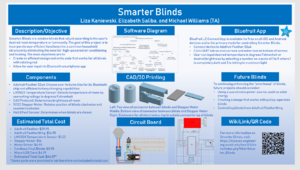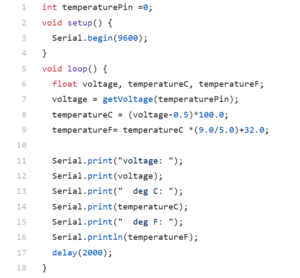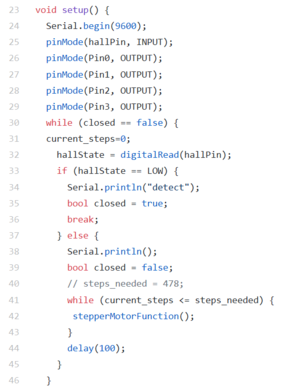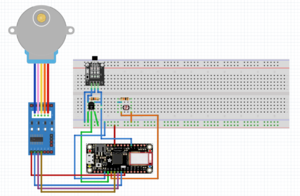Difference between revisions of "Smarter Blinds"
Lkaniewski (talk | contribs) |
|||
| Line 69: | Line 69: | ||
=== Gantt Chart === | === Gantt Chart === | ||
| − | [ | + | [https://docs.google.com/spreadsheets/d/10uzT7YQ7MJU3zTquifuFkcKUptFDYlntzzncpx78SI4/edit?usp=sharing Gantt Chart ] |
| − | https://docs.google.com/spreadsheets/d/10uzT7YQ7MJU3zTquifuFkcKUptFDYlntzzncpx78SI4/edit?usp=sharing | + | [[File:Chart|thumb|Gantt Chart]] |
== Design and Solutions == | == Design and Solutions == | ||
Revision as of 23:38, 20 April 2019
Smarter Blinds
Contents
Proposal
Team Members
- Elizabeth Saliba
- Liza Kaniewski
- Michael Williams (TA)
Links
Budget: Nite Light & Smarter Blinds
Poster: file:///C:/Users/eliza/Documents/Intro%20to%20ED/Poster.pdf
Overview
New technology has allowed society to make improvements to daily items including thermostats and other objects around the home. Fascinated with this idea of do-it-yourself home improvement projects and the wide breadth of tasks that can be accomplished we have decided to make Smarter Blinds. We will be creating blinds that move according to user input. By incorporating aspects that allow the blinds to move according to sunlight and temperature in the room to eliminate the use of air conditioning or heating we hope to make our blinds energy efficient. This way, our hope is that energy consumption in the home will be reduced through our creation of Smarter Blinds.
Objectives and Goals
- Have the blinds open from being completely closed to open over a period of time set by the user
- Make the design efficient and compact so that it could work for all blinds that utilize rotating rod to open/close
- Have a user inputted preferred light intensity so that the blinds move throughout the day according to desired intensity.
- Make eco-friendly functions that increase/decrease the amount of light let in, which lessens the need for air conditioning/heating
- Find a suitable power source for the blinds such as lithium batteries or potentially solar power
- If time allows, develop a way for the blinds to be controlled on your mobile device via Adafruit App
Challenges
- Learning and effectively using Arduino
- Learning CAD and 3D printing skills with the goal of printing as many parts as possible to be cost effective
- Generating enough power to operate the blinds
- Determining the relationship between temperature, luminous intensity and blind angle
- Making sure the motor is strong enough to turn the blinds
- Creating a design that can be used on various blinds
- Designing a user-friendly app that connects to the blinds via Bluetooth
- Finding a way to determine position of blinds when initially turned on
- Transferring system from Arduino Uno to Feather
Budget
- Arduino UNO
- Digital Light Intensity Sensor Module for Arduino, $5.49 * Do not need to purchase
- RGB LCD Shield Kit for Character Display, $23.95 *Using Feather so now need a different part
- Adafruit FeatherWing OLED - 128x32 OLED Add-on For Feather $14.95
- LM35DZ Temperature Sensor, $1.23 (5)
- Solar Panel, $5.69 *not purchasing now
- Stepper Motor, $14
- Motor Driver, $4.95
- Arduino Feather ($29.95) *
- Adafruit Bluefruit LE UART Friend - Bluetooth Low Energy (BLE),$17.95 * Since using feather do not need this.
- Adafruit App, $0
- Estimated Total Budget: $57.77
- Note: With Feather: $87.72
- Note: With Bluetooth: $75.72
Current Parts Purchased / Have:
- Adafruit FeatherWing OLED - 128x32 OLED Add-on For Feather $14.95
- Digital Light Intensity Sensor Module for Arduino, $5.49 * Do not need to purchase
- LM35DZ Temperature Sensor, $1.23 (5) (ordered)
- Stepper Motor, $14 (may need to purchase additional if current one fails)
- Motor Driver, $4.95(may need to purchase additional if current one fails)
- Arduino Feather ($29.95)
Current Amount Spent: $49.44 + $7.15 = $56.59
Gantt Chart
Design and Solutions
Mechanics
Construction of Circuit
Initially, the temperature sensor, photoresistor, hall effect sensor, and motor were set up individually on the breadboard and tested with the Arduino. After troubleshooting individual threads of code and making sure each component functioned properly in the circuit, the components were set up together on the breadboard. The three legs of the temperature sensor are connected to positive, A0, and ground, respectively. For the hall effect sensor, the left leg of the hall effect sensor connects to a 10k resistor and then to positive, the middle leg connects to the right leg of the temperature sensor and then to ground, and the right leg connects to the other end of the 10k resistor and then to pin 12. One leg of the photoresistor connects to positive, and the other leg connects to one end of another 10k resistor and then to A1. The other end of the most recently mentioned 10k resistor connects directly to negative. For the motor, the gray wire connects to positive, and the brown wire connects to negative. The positive end of the circuit is then connected to 5V, which is labeled as USB on the Feather, and the negative end is connected to ground. This explanation can be clearly seen in the perfboard sketch pictured below. After determining all of these connections, everything was soldered onto the perfboard, along with pins to easily connect to the headers of the feather with jumper wires.
Functioning of Blinds
Using the rotating device located at the top of the blinds, it takes approximately 11 revolutions to open the blinds from 0 degrees (with the flaps completely shut) to 90 degrees (with the flaps parallel to the ground). 11 revolutions is equal to 44,836 steps taken by the stepper motor; therefore, it takes approximately 498.2 steps to move the blinds 1 degree.
3D Printing
OnShape software was used to design the connector between the blinds and the stepper motor as well as the enclosure for the Feather, perfboard, and motor. The enclosure is designed to easily clamp on and off of the top of any blinds without any messy installation. A circular extrusion from the part of the enclosure that holds the motor and motor driver allows for a connector to be attached between the rotating hook of the blinds and the motor.
Mounting Blinds
For presentation purposes, the blinds were attached to the bottom of the table using two pieces of plywood.
Programming
Detecting Temperature of Room
An LM35DX temperature sensor measures the temperature of the room in which the blinds are located. The voltage is detected from the temperature pin, and this value is converted into degrees Celsius and then into degrees Fahrenheit, as seen in lines 7 through 9 of the code.
Detecting Luminosity of Room
The CdS photocell (photoresistor) detects the amount of light in the room in which the blinds are located. Values read from the photocell are converted to brightness on a scale of 1-5, which was done to prevent user confusion with unfamiliar brightness values.
Receiving User Input
Smarter Blinds are controlled by the Adafruit Bluefruit LE Connect App, which is available for free on both iOS and Android devices. Any device can pair with the Adafruit Feather 32u4 on the opening page of the app which connects via the Feather's built-in Bluetooth chip. Once the device is connected to the Feather, the user will click the UART tab. On the bottom of the UART screen is a textbox where the user will be directed to enter their desired room temperature or brightness.
Setting Initial Position of Blinds
The Hall Effect sensor determines when the blinds are closed. A strong magnet is mounted on the blinds so the blinds are completely closed when the magnet is detected. While the magnet is not detected, the motor is directed to continue rotating the blinds in the counterclockwise direction. Once the magnet is detected the blinds will be closed, which is the desired initial position for calling other functions.
Opening and Closing the Blinds
A 5VDC Stepper Motor is used to rotate the position of the blinds in both clockwise and counterclockwise directions. The stepper motor opens from 0 degrees, letting in no light, to 90 degrees, letting in the maximum amount of light. The stepper motor code directs the motor to move in increments of blind-degrees; therefore, the stepper motor takes ### steps in order to move one degree.
Formulas
The user inputs a number from 1 to 5 indicating how bright they would like the room to be. The photoresistor has a max value of 1023. Therefore, the formula for converting the number inputted to a value that corresponds with the photoresistor values is 1023/5 multiplied by the user input value. 5 corresponds to very bright and 1 corresponds to a very dark room.
Another formula created was to correlate the position of the blinds to the brightness desired. The position of the blinds that correlates to the brightest setting is when the blinds are perpendicular to the window letting a maximum level of light pass through. The motor, after initialized moves the blinds 45 degrees then however many more degrees needed to position the blinds at the desired brightness. This formula is steps_needed = (4076 * 5.5) + (5 - bright_scale) * (4076);
Electronics
We chose to use the Arduino Feather rather than the Arduino Uno because of the Feather's Bluetooth chip and efficient battery charging capabilities. Since the primary method for controlling the Smarter Blinds is via the Adafruit Bluefruit app, the Feather allowed us to bypass connecting a separate Bluetooth device. Another benefit of the Feather is that it can be powered by a microUSB cable that is plugged into a wall outlet. Therefore, there isn't the worry of running short on power.
Results
Next Steps
References
Resources
- Past Projects
https://classes.engineering.wustl.edu/ese205/core/index.php?title=Smart_Blinds https://www.hackster.io/Froz3nArcher/smart-blinds-573548 https://www.hackster.io/rjacobo2/lane-tech-hs-pcl-iot-smart-blinds-42a68a (potential design idea)
- Stepper Motor and Arduino
Arduino Modules - L298N Dual H-Bridge Motor Controller Controlling DC Motors with the L298N Dual H-Bridge and an Arduino
- Bluetooth Connection
Adafruit Bluefruit LE UART Friend - Bluetooth Low Energy (BLE) Adafruit Feather 32u4 Bluefruit LE Adafruit Feather 32u4 Bluefruit Overview
- Soldering
Soldering YouTube How to Solder
- Temperature Sensor
- Photoresistor






